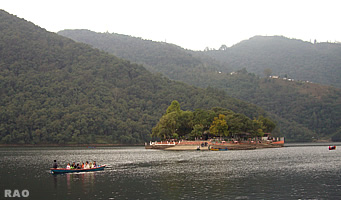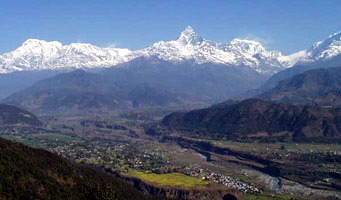Annapurna
area: Efforts
to
discourage illegal trekking agents
|
| March
2003 |
The
spring season is considered appropriate for trekking to the Annapurna Base
Camp, Pun Hill, Jomsom and other trekking routes in the Annapurna Circuit.
Consoled by the recent declaration of truce between the government and
the Maoists, and fascinated by the onset of spring season, the number of
visitors coming to Pokhara has increased, most of whom would go on trekking.
Trekking
Agents Association of Nepal (TAAN) Pokhara and Union of Trekking Travel
Rafting Labourers want to discourage the unauthorised trekking agents serving
in the Annapurna area. In order to curb the self-appointed trekking agents
serving in the Annapurna area, these two trekking bodies have started a
week-long sudden inspection check at three major points en route the Annapurna
area from Pokhara, namely Gaunda Fedi, Bire Thanti and Pokhara Bus Park.
The inspection teams will check whether a trekking group is accompanied
by an unauthorised trekking agent or not. About 60 per cent of the trekkers
going to Annapurna area from Pokhara are served by unauthorised agents.
Generally, the hotels arrange such unauthorised trekking agents to its
clients.
"The
unauthorised trekking agents are not trained and hence less competent.
It is impossible for the trekkers to receive quality service and proper
guidance from such agents. On the other hand, their wages are not fixed
and they do not get health insurance facilities. If they are not clever
enough, it is possible that they are cheated on their pay," TAAN officials
stated. To be an authorised trekking agent, one has to obtain licence from
TAAN. |
Paragliding
in Pokhara
|
| March
2003 |
Paragliding
as an adventure sport, is slowly catching the fancy of the citizens of
Pokhara and with proper government support the region around Pokhara could
be easily developed into a paragliding destination for lovers of the esoteric
sport. Paragliding, very similar to a bird gliding across the open sky,
which apart from being an exciting experience, provides a moving birds-eye
panorama of the world below. While gliding through the skies of Pokhara
one can get a clear view of snow-peaked mountains such as Machhapuchhre,
Annapurna range, and various ponds and ravines, settlements of the Gurung
scattered across the valley and glimpses of the popular Pokhara Bazaar
in all its glory.
Paragliding
had been introduced in Nepal seven years ago under a firm registered as
Sunrise Paragliding. Till date 2000 foreigners have traversed the skies
of Pokhara. There are already a few foreigners wanting to paraglide in
the natural beauty of this already popular tourist spot from above the
veil of white clouds. For flying and learning new paragliding skills, Pokhara
seems to be the ideal place.
Nepalese
wanting to get into the air for 30 to 40 minutes of gliding time require
to pay Rs. 3000, while foreigners are charged 70 U.S. dollars. However,
foreigners with their own equipment do not have to make any payments.
Paragliding
can be done in Pokhara throughout the year, except for the four months
from April to July . The Sunrise institute has been conducting paragliding
takeoffs from two points along the northern ridge of Sarangkot hill, leased
to them by the Sarangkot VDC for a sum of Rs. 70,000 per year. |
Unlicensed
trekking guides
in
Pokhara
|
| December
2002 |
Though
the Tourism Act of the country provisions that only registered trekking
agents should guide the tourists, the local hotels employ unauthorised
trekking guides. Almost seventy per cent of tourists thronging this
beautiful city of lakes come mainly for trekking to Annapurna Conservation
Area. According to Trekking Agents Association of Nepal, almost 40 per
cent of the tourists visiting this city are directly taken to trekking,
guided by their 'unskilled' porters and guides. Last year, the number of
tourists visiting Pokhara was 70 thousand. The number of legally
registered trekking agents is 35 in Pokhara. Whereas about 450 guides
and porters have taken licences from Pokhara. According to the Act, even
the porters have to be licensed. The unlicensed guides being employed by
the local hotels are not even insured.
|
Pokhara
tourism
threatened
by air pollution
|
| October
2002 |
A thick cloud of fog and haze has hidden the peaks of Mt. Machhapuchhre,
Annapurna and Dhaulagari for more than a week, even if the mountains are
just 30 kilometres from the valley. Not even a single tourist has made
a trip to the top of Sarangakot, a must-visit site for sunrise views and
a panorama of the mountains. Experts have attributed the worsening climatic
situation in the valley to excessive pollution by vehicles and industries
alike. "If pollution goes unchecked, the peripheral mountains will not
be visible from the valley after 15 years,"an expert said. It has been
just six to seven years since fog and haze started covering the sky of
Pokhara. Fog and haze have been increasing in the sky of the valley which
is a serious threat to tourism. |
Syangja:
Tourism village deserted
|
| September
2002 |
Just
at the start of the autumn tourist season this year, many tourists have
returned from Panchamul-Sirubari, the famous rural tourism destination
of Syangja district, without really relishing their visit due to growing
Maoist activity there. With the growth in tourism, cottage handicraft such
as woollen caps, blankets and bags were flourishing in the rural area.
The concept of rural of village tourism had been gaining popularity with
tourists from Asia and even western countries. With the Maoists becoming
active in village, tourism areas such as Panchamul-Sirubari area near Pokhara,
Tansen and even Lumbini, the mood in the hills is rather sombre.
|
Pokhara:
Drinking water shortage in Pokhara
|
| September
2002 |
Pokhara
City faces a water shortage that may soon exceed that of the Kathmandu
Valley. The cause of the water crisis is mounting population growth due
to migration. The tourist valley has a water demand of over 30 millions
litres per day while it has the capacity to supply only 1.5 million litres
of water in the dry season and 2.5 million litres of water during the monsoon
season. Pokhara has a population growth rate of seven to eight percent
per year. Hotel owners are facing the largest challenge when it comes to
supplying water. Except for a few large hotels that supplement their water
supply by pumping ground water, other hotels can barely extend their water
reserves to meet the demand. Water to the city is fed from three
sources. Mardi River at Hemja Lachok, 11 kilometres outside of Pokhara
Valley, is the main water source while Klimuda and Baldhara rivulets at
Armala Village of Syangja district also supply water to the city. |



